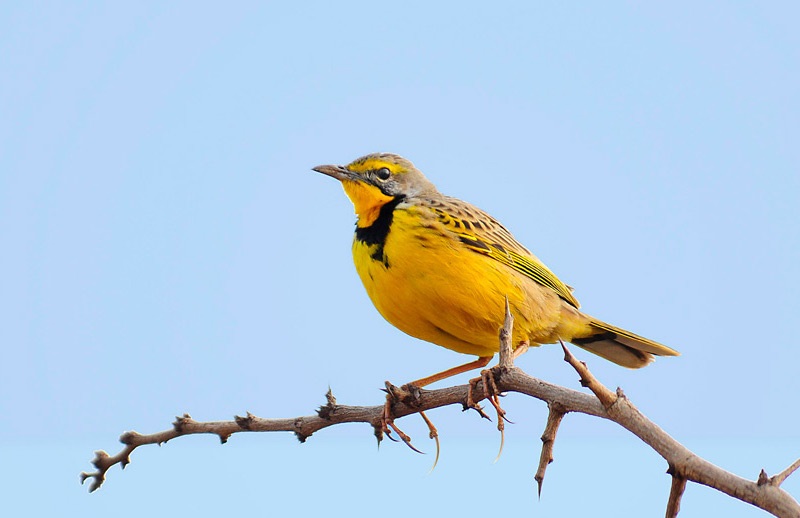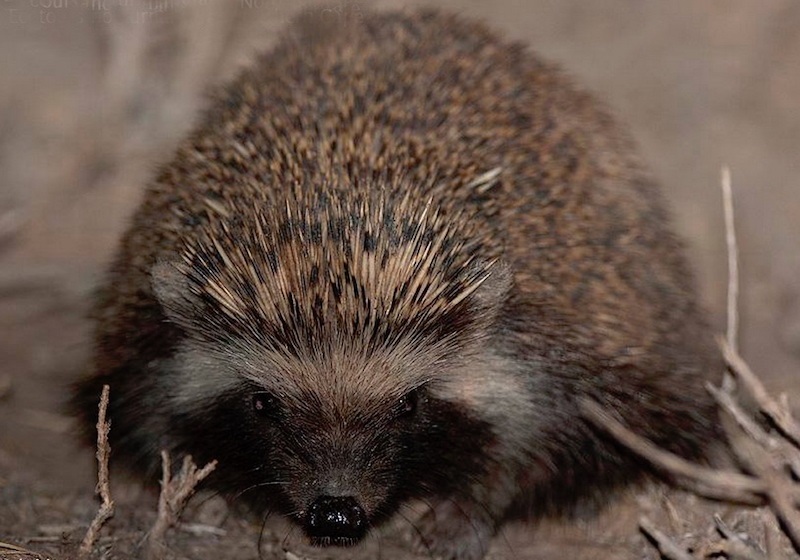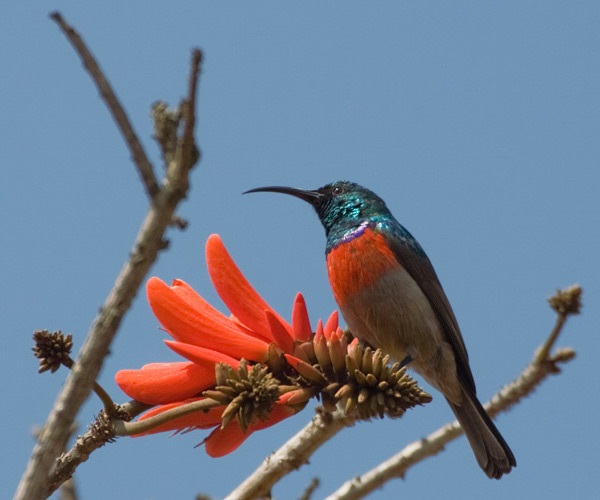The province of Mpumalanga is located in north-eastern South Africa, bordered by Mozambique to the east and Swaziland to the south-east. The province has great historic, scenic and wildlife diversity. A considerable variation in altitude and ecological zones has produced a rich and varied bird population occurring over a mosaic of grassland, forest, wetland, savanna and mountain habitats. The northern Drakensberg range separates the relatively cool, temperate Highveld from the sweltering, sub-tropical Lowveld. Rivers are mainly east-flowing, the most important being the Crocodile, Sabie and Olifants. The entire province is a summer rainfall region, with rainfall ranging from 350mm in the north-east Lowveld to 1,600mm per annum at the higher altitudes. On the Escarpment heavy mists afford extra moisture which can be up to 50% of the annual precipitation. Cold winters are experienced over the Highveld, with occasional snow on the Escarpment, but in the Lowveld the winters are short and mild. Summers are mild to warm on the Highveld, but can be exceptionally hot in the low-lying parts of the Lowveld.

Birding habitats in Mpumalanga comprise:
Afro-montane Forest, which is confined to the mistbelt of the Escarpment, usually in fire-protected gorges or moist south-facing slopes. Endemics favouring this habitat include Chorister Robin-Chat, Knysna Turaco, Bush Blackcap, Barratt’s Warbler and Forest Canary, with other specials being Orange Ground Thrush, White-Starred Robin, Yellow-throated Woodland-Warbler, Olive Bush Shrike, Swee Waxbill and Narina Trogon.
Acacia/Broad-leaved Savannah occurs in low-lying areas below the Escarpment and on the foothills. Vegetation structure varies from dense thorny thickets to tall, park-like woodland. Large tracts of savannah are conserved in the Kruger National Park. This habitat holds the greatest number of bird species, including numerous raptors, shrikes, hornbills, barbets, rollers, woodpeckers, bee-eaters, bustards and many, many more. It has the distinction of hosting both the largest and smallest of South Africa’s birds, namely Ostrich and Grey Penduline Tit. Savannah dominated by thorn trees (Acacia species) usually has a more diverse bird community than broad-leaved woodlands, but the woodlands in the south-western Lowveld have a number of special birds such as Yellow-bellied and Green-capped Eremomelas, Pale Flycatcher, Bushveld Pipit, Croaking and Lazy Cisticolas, Striped Pipit, Yellow-throated Petronia and African Firefinch.
Dry Bushveld is found in the low-rainfall region of north-western Mpumalanga and is dominated by thorn trees (Acacia species). While a number of species are shared with the moister eastern savannahs, there are several unique species such as Crimson-breasted Shrike, Black-faced and Violet-eared Waxbills, Shaft-tailed Whydah, Great Sparrow and Pied Babbler.

Montane Grassland covers most high-altitude mountains. This is the most important habitat in Mpumalanga for finding some of South Africa’s endemic birds, a number of which are rare and localised. The list includes mouth-watering specials such as Rudd’s and Botha’s Larks, Yellow-breasted and African Rock Pipits, Southern Bald Ibis, Blue and Barrow’s Korhaans, Ground Woodpecker, Sentinel Rock Thrush, Buff-streaked Chat and Blue Crane. Mist-belt grassland, a form of montane grassland confined to mist-shrouded parts of the Escarpment, is one of South Africa’s most threatened habitats, with much being covered by plantations of exotic trees. These sterile, man-made forests have replaced most of the rich grasslands to the detriment of many species, the most renowned example being the Blue Swallow.
Highveld Grassland once occurred over much of western Mpumalanga, but has now largely been transformed into fields of maize. Where pockets of grassland remain, the birding can be surprisingly good, common species including Long-tailed Widowbird, Yellow-Crowned Bishop, Cape Longclaw and Marsh Owl. A number of specials can still be found including Botha’s Lark, Pink-billed Lark, Grass Owl, Black-winged Pratincole and Montagu’s Harrier.
Wetlands are most prominent on the Escarpment (marshes) and Highveld (shallow, open pans). The dominant waterbodies in the Lowveld are rivers and man-made dams. High-altitude marshes on the Escarpment form vital breeding habitat for two endangered species, Wattled Crane and the enigmatic White-winged Flufftail. The shallow Highveld pans are often home to large numbers of waterfowl, including Cape Shoveller, Hottentot Teal, Southern Pochard, South African Shelduck and Maccoa Duck, and others like Greater Flamingo, African Spoonbill and Chestnut-banded Plover. Special birds along Lowveld rivers include African Black Duck, African Finfoot, Goliath Heron, African Pied Wagtail and Half-collared Kingfisher.
Cliffs and mountain peaks are mostly confined to the Escarpment. Birds favouring this habitat include Verreaux’s Eagle, Jackal Buzzard, African Black Swift, Black Stork and the extremely rare Taita Falcon.

Apart from Kruger (see that destination page) there are several terrific reserves, two examples are:
Mount Sheba Nature Reserve (Map) is a small reserve has some of the best accessible Afromontane forest left in Mpumalanga. Mount Sheba Hotel is situated in the Escarpment hills above the historic gold-mining village of Pilgrim’s Rest, on a grassy knoll surrounded by forest. A well-laid network of trails cover much of the forest and grassland on the upper hill slopes.
Some Southern African endemics to be found in the forest include Knysna Touraco, Chorister Robin-Chat, Cape Batis, Olive Bush Shrike, Southern Double-collared Sunbird and Forest Canary. Grasslands and rocky outcrops have endemics like Grassbird, Drakensberg Prinia, Gurney’s Sugarbird (around flowering protea bushes); Cape Rock Thrush and Buff-streaked Chat.

Blyde River Canyon Nature Reserve (Map) is the third-largest canyon in the world and one of Africa’s scenic wonders. The Blyde River flows through this 700-metre deep chasm into the Swadini Dam at the mouth of the canyon. The 27 000-hectare Blyde River Canyon Nature Reserve supports a diverse range of habitats, including mistbelt grassland, sheer cliffs, riverine forest and dense savanna. Two Aventura Resorts operate in the reserve, one above the canyon and the other below, offering excellent accommodation and ideal opportunities to explore a network of walking trails.

Well-wooded resort grounds offer some of the best birding in the nature reserve, including Mocking Cliff-Chat, Cape Rock Thrush, Striped Pipit, Knysna and Purple-crested Turacos, Drakensberg Prinia, Lazy Cisticola, African Pied and Long-tailed Wagtails, Greater and Southern Double-collared Sunbirds, Orange-breasted and Olive Bush Shrike, Brimstone Canary and Golden-breasted Bunting. Viewpoints into the canyon are ideal for raptor watching and this must rate as one of South Africa’s raptor hot-spots. Regular sightings include Verreaux’s Eagle, Cape Vulture, Jackal Buzzard, Lanner Falcon, African Goshawk and White-necked Raven. The ultimate prize is Taita Falcon – an incredibly rare little falcon that nests nearby and occasionally flies over.
Text Source: Fatbirder
Photo Source: Birding Ecotours
Map Source: Google Maps
